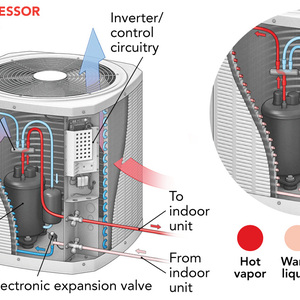The total peak heat load for this house is 21,000 Btu. To put that into perspective, 21,000 Btu is about the heat load that you’d have for a bedroom suite in a code-built house, yet we have that same heat load in this entire home with 4700 sq. ft. of conditioned space.
Not only do we have an incredibly low heat load, we also have equipment that sips energy—that uses as little energy as possible—but still maintains a healthy and properly tempered indoor environment.
This is accomplished by using components that are not often paired together on the U.S. market: the Minotair HRV (heat-recovery ventilator system); a hydro coil; a Sanden water heater; and a high-performance Mitsubishi heat-pump air handler.
Watch the full video to learn more, including:
- How these systems work together at different times of the year
- How the heat pump of the Minotair captures a substantially larger amount of energy from the air stream than normal air-conditioning units and transfers it into sensible energy to achieve both ventilation and air conditioning
- What makes the Sanden water heater achieve a high coefficient of performance
___________________________________________________________
Ben Bogie is a second-generation high-performance-building obsessive working as a project manager for BPC Green Builders of Wilton, CT.
Weekly Newsletter
Get building science and energy efficiency advice, plus special offers, in your inbox.















11 Comments
Have you done a cost comparison from this system to one that swaps the Minotair for a standard ERV and a heat pump with 5000BTU/h more capacity? I can't imagine this system coming out cheaper, given the enormous cost of the Minotair and the minimal incremental cost for a larger heat pump. I've never seen a logical explanation for using a CERV unless it's able handle the whole house load, thus saving the expense of another heat pump.
Also, 21kbtu/h for a master bedroom seems high for a code built house. Wouldn't that imply a whole house load in the ballpark of 200kbtu/h?
I'd also like to see a comparison of the energy requirement for those two systems. Yes, the Minotair takes advantage of the heat content of the exhaust and gets some "free energy" out of it, but so does an ERV. Counterflow heat exchangers allow you to get amazingly close to ideal performance, and I haven't see any evidence that what you get from the Minotaur is worth what you give up by not having a conventional ERV.
Charlie,
What do you give up by not having a traditional ERV? It seems to me that you still get the fresh air, it's just tempered a bit more. While not necessarily good economics, it seems that this setup would reduce the issue of rooms with supply air slowly normalizing to outdoor conditions when the main HVAC system is not running. Giving the Minotair priority should help reduce temperature differences that occur with central-head minisplits. Seems like a solid approach.
I have no doubts that it conditions air very effectively and comprehensively. My doubt is only about the energy efficiency. My best guess is that it's better than a minisplit plus exhaust-only ventilation, but worse than a minisplit plus ERV in that regard. I would assume that if the energy consumption was lower than the latter system, there would be a white paper on the website touting that advantage.
Thanks for asking the question as I see that I wasn't clear about what my doubt was.
I've been under the impression that, at least one source of savings would be the fact that it's acting against the undiluted source streams, for example, dehumidifying a fully saturated source of air. That feels like it would be cheaper than trying to wring it out of thoroughly diluted air.
You also get the added benefit of some pretty flexible humidity control. You can select how much humidity you capture or not. Probably cheaper than running a separate dehumidifier, humidifier, and ERV.
From a purely efficiency based consideration, maybe pairing it with an ERV would be more effective, but then you have to worry about defrost cycles, and you can't adjust humidity control the same way.
Maybe then something like the Air Pohoda/Jablotron Futura iERV, paired with a heat hump. However, as far as I'm aware, that isn't available here, and maybe the technology starts to get more problematic boosting the complexity that far.
In the end, maybe the Minotair isn't the most efficient possible, but considering flexibility, control, and reliability, it might be hitting a sweet spot.
I personally wish it had the ability to boost to move a lot more air. Even prior to Covid, I was interested in what many would consider extreme ventilation rates, and with Covid, I'd like to be able to push them even higher.
“[Deleted]”
Please correct me if I am wrong..
Do I see Internal sheating? Fiberboard outside and then blown cellulose?
Regards
You are correct, Bas. That is interior sheathing. This house has some unusual assemblies. You can read more about it on Ben's recent post: Interior Sheathing and Exterior Fiberboard Insulation.
Hi Kiley,
Yes - well - that is behind the prime wall. Would have loved to give my 2 Cents there...
Regards
Actually - there is fiberboard available to act as temporary structural sheathing so that you can Weather the house in fast without the internal sheathing - at least that was what was done at some sites i followed. Was done panelized and the wall came up fast.
That sounds interesting to learn about, thanks for sharing. One of Ben's takeaways from this project was: If you are doing something just to be novel, don't do it. There are plenty of proven and trusted high-performance assemblies out there to work with.
Interesting thanks.. But your link to "Interior Sheathing and Exterior Fiberboard Insulation." takes you back to this same url address.
Log in or create an account to post a comment.
Sign up Log in